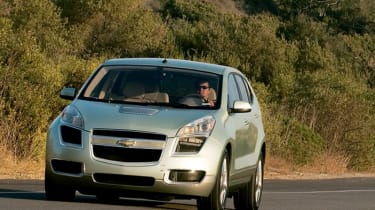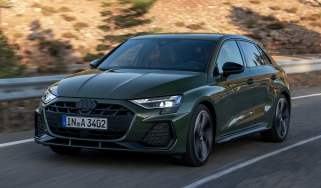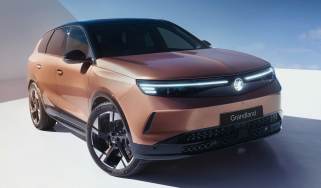Chevrolet Sequel
The world’s most advanced car – that’s what Chevrolet calls its sensational Sequel hydrogen fuel cell 4x4
The Chevy Sequel is the most exciting fuel cell car we have ever tried. Its drive-by-wire steering needs some work, and question marks remain over the viability of hydrogen fuel cells. But the performance, range, off-road ability and packaging make this the most convincing hydrogen vehicle yet.
Said to be the first futuristic zero-emissions vehicle you could drive every day, it is miles ahead of the competition – but is it the future?
First seen at the 2005 Detroit Motor Show, the Sequel features GM’s Gen-4 fuel cell system packaged into a ‘skateboard’ chassis that’s only 28cm thick.
There are no mechanical linkages to speak of – the steer, drive and brake-by-wire systems remove the need for physical connection. The Sequel also has in-wheel electric motors that give it full 4x4 capability, which no other working fuel cell car can offer. Incredibly, it’s road-legal, too. Start it up and the powerful cooling system emits a high-pitched whine. From outside it sounds like a jet aircraft with the volume turned down.
Inside, the digital instruments have bars denoting hydrogen levels. A screen displays the flow of energy, Toyota Prius style, but otherwise the cabin is very normal – it even has a tatty ignition key. Yet there’s nothing dated about the powertrain. It’s smooth and quiet, and gives good pace for a 2,170kg car. A 0-62mph time of 10 seconds and a 90mph top speed put it in a fuel cell class of its own.
Between the fuel cell power module, battery pack, 65kW front electric motor and two 25kW in-wheel motors, the Gen-4 propulsion system delivers up to 200bhp. But after a few minutes of sustained acceleration, the lithium-ion batteries fall below required charge levels, halving the power on tap.
This won’t normally be an issue, and the Prius-style regenerative braking and electric motor system soon has it back up to full charge. But the set-up needs fine-tuning before it can rival a combustion engine for everyday usability.
Three high-pressure storage tanks hold 8kg of hydrogen, meaning a 300-mile range between refills. That ‘skateboard’ chassis gives perfect 50:50 weight distribution, so the handling and body control impress. Our only gripe is the variable-ratio steer-by-wire, as it’s unresponsive, with inconsistent feel. As with the braking and throttle response, though, this could be reprogrammed at a dealer. The Sequel may be a turning point in making hydrogen cars a reality.



